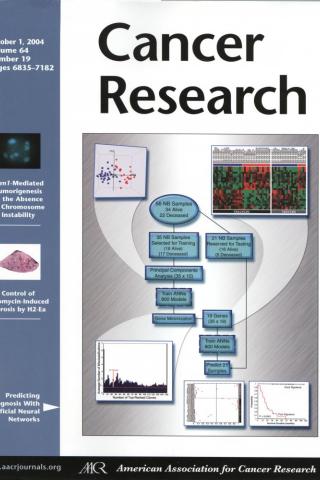
Jun S. Wei, Ph.D.
- Center for Cancer Research
- National Cancer Institute
- Room 1016A, Building 37
- Bethesda, MD 20892
- 240-760-7428
- weij@mail.nih.gov
RESEARCH SUMMARY
The mission of the Oncogenomics Section is to harness the power of high throughput genomic and proteomic methods to improve the outcome of children with high-risk metastatic, refractory and recurrent cancers. The Oncogenomics Section has been pioneering systematic, high-throughput approaches including microarrays, next-generation sequencing technologies, and large-scale screenings to study pediatric cancers. The research goals are to integrate the data, decipher the biology of these cancers and to identify and validate biomarkers and novel therapeutic targets and to rapidly translate our findings to the clinic.
Areas of Expertise
Research
The mission of the Oncogenomics Section is to harness the power of high throughput genomic and proteomic methods to improve the outcome of children with high-risk metastatic, refractory and recurrent cancers. The Oncogenomics Section has been pioneering systematic, high-throughput approaches including microarrays, next-generation sequencing technologies, and large-scale screenings to study pediatric cancers. The research goals are to integrate the data, decipher the biology of these cancers and to identify and validate biomarkers and novel therapeutic targets and to rapidly translate our findings to the clinic.
Publications
Targeting wild-type and mutationally activated FGFR4 in rhabdomyosarcoma with the inhibitor ponatinib (AP24534)
Comprehensive genomic analysis of rhabdomyosarcoma reveals a landscape of alterations affecting a common genetic axis in fusion-positive and fusion-negative tumors
Clinically Relevant Cytotoxic Immune Cell Signatures and Clonal Expansion of T Cell Receptors in High-risk MYCN-not-amplified Human Neuroblastoma
MYCN controls an alternative RNA splicing program in high-risk metastatic neuroblastoma
Aurora B kinase is a potent and selective target in MYCN-driven neuroblastoma
Biography

Jun S. Wei, Ph.D.
Dr. Wei received his B.Sc. degree in biology at University of Houston in 1992. He subsequently obtained a Ph.D. degree in the cardiovascular sciences program in the Debakey Heart Center at Baylor College of Medicine in 1999. After completion of a postdoctoral training in Dr. Paul Meltzer's lab at the Cancer Genetics Branch of the NHGRI, he joined the Oncogenomics Section in 2001, and became a staff scientist since 2009. Dr. Wei currently assists Dr. Javed Khan to oversee the on-going research projects at the Oncogenomics Section. His primary research interest is to understand the biology of high-risk pediatric cancers using genomic approaches.
Covers

Prediction of clinical outcome using gene expression profiling and artificial neural networks for patients with neuroblastoma
Abstract
Currently, patients with neuroblastoma are classified into risk groups (e.g., according to the Children’s Oncology Group risk-stratification) to guide physicians in the choice of the most appropriate therapy. Despite this careful stratification, the survival rate for patients with high-risk neuroblastoma remains <30%, and it is not possible to predict which of these high-risk patients will survive or succumb to the disease. Therefore, we have performed gene expression profiling using cDNA microarrays containing 42,578 clones and used artificial neural networks to develop an
accurate predictor of survival for each individual patient with neuroblastoma. Using principal component analysis we found that neuroblastoma tumors exhibited inherent prognostic specific gene expression profiles. Subsequent artificial neural network-based prognosis prediction using expression levels of all 37,920 good-quality clones achieved 88% accuracy. Moreover, using an artificial neural network-based gene minimization strategy in a separate analysis we identified 19 genes, including 2 prognostic markers reported previously, MYCN and CD44, which correctly
predicted outcome for 98% of these patients. In addition, these 19 predictor genes were able to additionally partition Children’s Oncology Group-stratified high-risk patients into two subgroups according to their survival status (P 0.0005). Our findings provide evidence of a gene expression signature that can predict prognosis independent of currently known risk factors and could assist physicians in the individual management of patients with high-risk neuroblastoma.
Prediction of clinical outcome using gene expression profiling and artificial neural networks for patients with neuroblastoma. Wei JS, Greer BT, Westermann F, Steinberg SM, Son CG, Chen QR, Whiteford CC, Bilke S, Krasnoselsky AL, Cenacchi N, Catchpoole D, Berthold F, Schwab M, and Khan J. Cancer Res. 2004 Oct 1;64(19):6883-91.
